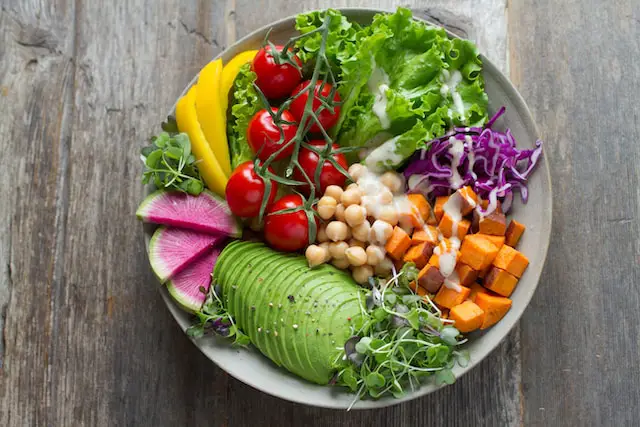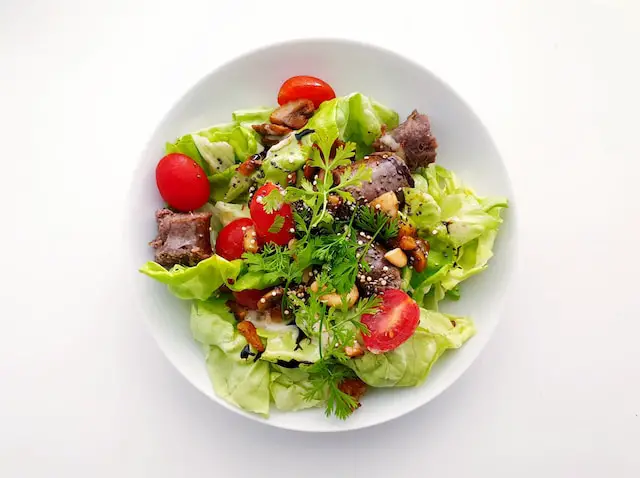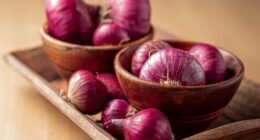The main difference between coleslaw and salad is that coleslaw is typically made with shredded cabbage and a creamy dressing, while salad can be made with a variety of ingredients and dressings. Additionally, coleslaw is often served as a side dish, while salad can be a main dish or side dish.
What is coleslaw?
(Image by Wow Phochiangrak from Pixabay )

Coleslaw is a classic side dish that originated in the Netherlands but has become popular worldwide. The word “coleslaw” comes from the Dutch term “koolsla,” which means cabbage salad. Coleslaw typically consists of shredded cabbage, carrots, and mayonnaise-based dressing.
There are many variations of coleslaw, with some recipes adding other vegetables like red onion or bell peppers for additional flavor and crunch. Some people also like to add raisins or nuts for texture.
One thing to note about coleslaw is that it can be served either cold or at room temperature. It’s often served as a side dish alongside barbecue or fried chicken.
Coleslaw is not only delicious but also has health benefits since it contains fiber and nutrients found in cabbage and other vegetables used in its preparation. Coleslaw is a versatile and tasty dish that’s perfect for any occasion!
What is salad?
(Photo by Anna Pelzer on Unsplash )

Salad is a dish that usually comprises of raw vegetables, fruits, nuts and dressings. It could be served as an appetizer or a main course meal depending on the recipe. The beauty of salads lies in its versatility- you can customize it to your liking by adding or removing ingredients based on personal preferences.
The components of salad are typically fresh greens such as lettuce, spinach or kale supplemented with other vegetables like tomatoes, cucumbers etc., Fruits like strawberries or mandarins can also be added for sweetness while nuts such as almonds or cashews add texture and crunchiness.
Dressings play a vital role in enhancing the flavor profile of salads. Some common dressings used include vinaigrettes which comprise vinegar, oil and herbs; mayonnaise-based dressing which has egg yolks and mustard combined with oil; yoghurt-based dressing – this adds tanginess to the salad.
There is no limit to how you can prepare your salad – from simple recipes using just few ingredients to more complex ones having multiple elements working together for deliciousness!
Coleslaw Vs. Salad – Key differences
Coleslaw and salad are two dishes that often get mixed up, but they do have distinct differences. Firstly, coleslaw is a type of salad made from shredded raw cabbage mixed with mayonnaise or vinegar-based dressing. On the other hand, salads can be made from a variety of ingredients such as leafy greens, fruits, vegetables and proteins.
The texture and consistency of coleslaw differ significantly from regular salads. Coleslaw has a crunchy texture due to its main ingredient being shredded cabbage while salads usually have soft or tender textures because they contain leafy greens.
Another key difference between these two dishes is their flavor profile. Coleslaws tend to have sweet and tangy flavors whereas salads can range from sweet to bitter depending on the ingredients used in them.
Coleslaws are generally served cold as a side dish for BBQs or sandwiches while Salads can either be served warm or cold as an entrée.
It’s important not to confuse these two delicious dishes since they offer different textures and flavors that complement different meals perfectly!
What goes well with coleslaw?
Coleslaw is a versatile side dish that pairs well with many different types of meals. Its creamy texture and tangy flavor make it the perfect complement to grilled meats, sandwiches, and even tacos.
One classic pairing for coleslaw is with barbecue dishes such as pulled pork or ribs. The coolness of the slaw balances out the smoky flavors of these meat-heavy dishes. Coleslaw also goes great with fried chicken or fish, adding some lightness and crunch to fried foods.
For those who prefer lighter fare, coleslaw can be an excellent addition to vegetarian meals like falafel wraps or veggie burgers. It adds some much-needed texture and creaminess while still keeping things healthy.
If you’re looking for something a bit more unconventional, try pairing your coleslaw with spicy dishes like buffalo wings or hot dogs. The refreshing nature of the slaw helps soothe any heat from these fiery foods.
There are many ways to enjoy coleslaw beyond just as a topping on your sandwich. Experimenting with different pairings can lead to delicious discoveries!
What goes well with salad?
When it comes to salads, the possibilities are endless. You can customize them based on your taste preferences and dietary needs. Here are some ingredients that go well with salad:
Protein : Adding protein such as grilled chicken, salmon, tofu or hard boiled eggs can make your salad more filling and satisfying.
Nuts and Seeds : Adding nuts like almonds or walnuts or seeds like pumpkin seeds adds a crunchy texture to your salad.
Fruits: Sweet fruits like berries, apples and citrus fruits add a burst of flavor and nutrition to your greens.
Cheese: Soft cheese like goat cheese or feta brings creaminess while harder cheeses like parmesan bring a salty tangy flavor.
Veggies: Cucumber, carrots, bell peppers – all these vegetables add color, crunchiness & nutrients in the bowl
Dressing: A good dressing is essential for any salad. Try simple vinaigrettes made from olive oil mixed with vinegar/lemon juice or creamy dressings made up of yogurt/mayonnaise based dressings
Incorporating different textures of ingredients will create an appealing balance ensuring you won’t get bored of eating the same thing every day!
How to make a simple coleslaw?
Coleslaw is a classic side dish that adds crunch and flavor to any meal. Making your own coleslaw at home is not only easy but also allows you to control the ingredients and customize it to your liking.
To make a simple coleslaw, start by shredding half of a head of cabbage into thin strips using a sharp knife or mandoline slicer. You can also add shredded carrots for extra color and texture.
Next, in a separate bowl, whisk together 1/4 cup mayonnaise, 2 tablespoons apple cider vinegar, 1 tablespoon honey, and salt and pepper to taste. Pour this mixture over the cabbage and carrots and toss until evenly coated.
If you want to add more flavor or texture, you can mix in some chopped green onions or parsley. Chill the coleslaw in the refrigerator for at least an hour before serving to let the flavors meld together.
That’s it! With just a few simple steps, you can whip up a delicious homemade coleslaw that pairs perfectly with burgers, sandwiches or grilled meats.
How to make a simple salad?
Making a simple salad is an easy and quick way to add some healthy greens to your diet. Here are some steps you can follow:
Choose your base
The first step in making a salad is choosing the base. You can use lettuce, spinach, arugula, kale, or any other leafy green vegetable of your choice.
Add some vegetables
Next, add some chopped vegetables such as tomatoes, cucumbers, bell peppers, carrots or any other vegetable that you like. Make sure to chop them into small pieces so that they mix well with the rest of the ingredients.
Add a protein source
Adding a protein source will make your salad more filling and satisfying. You can use grilled chicken breast strips, boiled eggs cut into pieces or chickpeas for vegetarians/vegans.
Add additional toppings
Add additional toppings such as nuts (almonds), seeds (sunflower seeds), cheese crumbles (feta) or dried fruits (cranberries).
Dress it up!
Finally dress up! Mix equal parts olive oil and vinegar of preference in a bowl with salt and pepper – pour over salad mixture right before serving!
In conclusion , making salads doesn’t have to be difficult! Just choose your favorite greens and veggies along with added proteins sources plus toppings and voila! A delicious meal full of vitamins & nutrients ready within minutes!
Health benefits of coleslaw and salad
Coleslaw and salad are both healthy meal options that offer various health benefits. Coleslaw is typically made with shredded cabbage, carrots, and a creamy dressing while salad can consist of any combination of greens, vegetables, fruits, nuts or seeds.
One major benefit of coleslaw and salad is their high fiber content. Fiber promotes digestive health by keeping the gut regular, aiding in weight management by increasing satiety levels after eating and lowering blood sugar levels.
Additionally, coleslaw and salad are both low in calories yet nutrient-dense making them great options for those looking to lose weight without sacrificing nutrition. They contain vitamins such as A,C,E,K,B6 as well as minerals like calcium potassium iron magnesium zinc etc., which help support overall bodily functions.
Another added benefit of these dishes is the ability to customize them according to personal preferences. Whether you prefer your coleslaw or salads loaded up with veggies or topped off with fruit & nuts; there’s an endless list of possibilities!
Consuming more coleslaw and salads can be beneficial for improving overall health outcomes while also promoting healthy eating habits.
Featured Image By – Tania Melnyczuk on Unsplash








